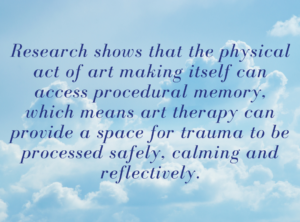Art Therapy: a space for trauma to be processed safely
When our lives are affected by adversity, it can have an impact on our wellbeing and this experience may be difficult to put into words, and this can be especially difficult for children and young people who have been affected by domestic abuse. Because of this, art therapists are often able to work with children and young people who have not be able to access talking therapies. Art therapy helps to ensure that no one is left behind.
What is art therapy?
Art Therapy is a form of psychotherapy that focuses on using art making as its primary mode of communication. The artwork created in the presence of an art therapist can provide a focus for discussion, helping the client reflect and make sense of behaviours and emotions that may feel confusing and hard to put into words.
Children and young people who attended Art Therapy at NIDAS are encouraged to use the art materials to express their experiences, to find the words to articulate how they have been affected by domestic abuse, and to support their wellbeing, and any social, emotional, and mental health needs.
Impact of domestic abuse on children and young people
Children and young people who have been affected by domestic abuse and trauma are more likely to experience mental health problems and behavioural difficulties. It is important to emphasise that the impacts of domestic abuse on children and young people are varied; they can be internalised and externalised and the effects can manifest at home, at school or in peer relationships.
Gender is also an important factor to consider when looking at the responses of children and young people who have experienced domestic abuse.
Girls: There is a tendency for girls to internalise the trauma and repress negative feelings that can be difficult to identify, which can result in neglecting their emotional needs, disassociation, feeling powerless, withdrawn and suffer from depression and anxiety.
Boys: Boys are more likely than girls to externalise their reaction and develop responses that may manifest in aggression, feeling responsible to look after siblings and other people and having a heightened sensory awareness.
For all children and young people affected by domestic abuse they may:
- Have nightmares and flashbacks
- Have very low-self-esteem
- Function on heightened alert
- Fear to make mistakes
- Can appear passive, clingy, anxious, withdrawn, isolated or lonely
- Be more likely to have disorganised attachment patterns
Children and young people are most likely to feel fear, shame and guilt arise from what they have experienced and endure the silence that surrounds domestic abuse. Art therapy can support children and young people in giving them a voice and to break the silence.
How can art therapy support recovery?
Art Therapy is an effective model for helping victims of domestic abuse to cope with symptoms of a wide array of emotional needs commonly caused by exposure to, and victimisation from, domestic abuse. In the cases of survivors of domestic abuse, art therapy techniques can be utilised to enable the expression of their emotions using visual arts to develop beneficial coping and self-soothing skills, both consciously and unconsciously, through sensory benefits of engaging in the creative process. Studies have shown that the sensory benefits that are present in many art therapy techniques can stimulate the middle brain, which is responsible for self-soothing, and emotional regulation. Developing calming skills through learning and engaging in art therapy techniques can aid in this pursuit is an invaluable practice for individuals who have experienced domestic abuse.

Art therapy also brings unique benefits in allowing procedural memory to be activated in the safe, contained way that is vital for psychodynamic work. Accessing procedural memory is key to the treatment of trauma as these types of memories are often located in the amygdala where responses to traumatic or situations like fright, flight, freeze or fight are determined. Research shows that the physical act of art making itself can access procedural memory, which means art therapy can provide a space for trauma to be processed safely, calming and reflectively. This bears relevance to work with children and young people who may have deeply buried memories of the domestic abuse they have experienced.
Through engaging in art therapy, clients can better understand their experience of domestic abuse and how they imagine their futures. Arts-based methodology gives shape to embodied and situated knowledge, accesses participants’ imagination and provides ways of focusing upon the future as well as the past and present, creating a sense of hope. Art therapy can aid a visual representation of the survivor’s transitional stories from domestic abuse, which is a powerful form of agency and resistance.
Mothers and children who have been affected by domestic abuse have a heightened need for accessing psychological support. As consequences of the affects of domestic abuse on children and due to the overwhelming practical and emotional stress of rearranging a life after domestic abuse, mothers may be feeling less emotionally available and their ability to respond to their children’s needs may be compromised, leaving implications for parenting and the parent-child relationship. Dyadic Art Therapy is a joined-up approach to art therapy involving children and their parents or caregivers in joint art therapy sessions. Enhancing psychological support, through dyadic art therapy represents a good opportunity to help mothers’ increase their understanding of their child’s feelings and heir own as reactions to the abuse they have suffered, to help increase emotional stability and safety for their child, consequently strengthening their relationship.
Referrals for NIDAS Art Therapy
If you are interested in finding out more about the NIDAS Art Therapy services and would like to make a referral for a client, please contact us on 01623 683 250, or email [email protected]. Alternatively, you can complete the NIDAS Art Therapy Referral Form and send it back to us.